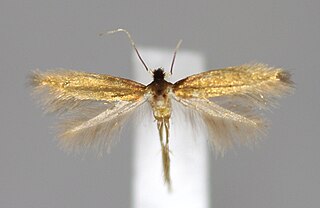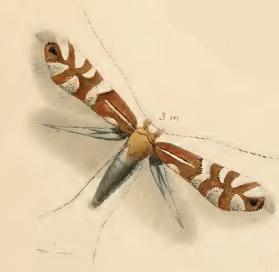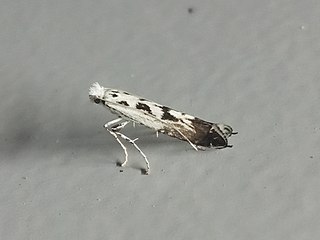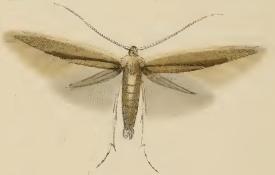
Bucculatrix canadensisella, the birch skeletonizer, is a moth of the family Bucculatricidae. The species was first described by Vactor Tousey Chambers in 1875. It is found in North America. In Canada, it has been recorded from New Brunswick to British Columbia, Nova Scotia and Prince Edward Island. In the United States, it has been recorded from New York, New Jersey, Michigan, Wisconsin, Minnesota, Pennsylvania, North Carolina, Tennessee, Kentucky and Colorado.

Eriocrania salopiella is a moth of the family Eriocraniidae and is found in Europe. It was described by the English entomologist, Henry Tibbats Stainton in 1854. The larvae mine the leaves of birch.

Eriocrania unimaculella is a moth of the family Eriocraniidae found in Europe. It was first described by the Swedish naturalist Johan Wilhelm Zetterstedt in 1839. The larvae feed inside the leaves of birch, making a mine.

Caloptilia populetorum is a moth of the family Gracillariidae. It is found in most of Europe, except Italy, the Balkan Peninsula and the Mediterranean islands.

Bucculatrix nigricomella is a species of moth of the family Bucculatricidae. It was first described in 1839 by Philipp Christoph Zeller. It is found in most of Europe.

Phyllonorycter ulmifoliella is a moth of the family Gracillariidae. It is found in all of Europe, east to Russia and Japan.

Parornix betulae is a moth of the family Gracillariidae. It is known from all of Europe, east to Korea. It was recently reported from Canada, with records from Québec, Ontario and British Columbia.

Parornix loganella is a moth of the family Gracillariidae. It is found from Fennoscandia and northern Russia to the British Isles, Denmark and the Baltic States.

Ornixola caudulatella is a moth of the family Gracillariidae. It is known from France, Italy, Germany, Austria, Poland, Hungary, Slovakia, the Czech Republic, Romania, Greece, Lithuania, Latvia, Estonia, Russia and Ukraine.
Dialectica geometra is a moth of the family Gracillariidae. It is known from Hong Kong, Japan, India and Réunion. It has recently been recorded from China.
Phyllocnistis habrochroa is a moth of the family Gracillariidae, known from Karnataka, India. The hostplant for the species is Abatia stellata. It was named by E. Meyrick in 1915.
Caloptilia pyrrhaspis is a moth of the family Gracillariidae. It is known from China (Sichuan), Japan and the Russian Far East.

Phyllonorycter martiella is a moth of the family Gracillariidae. It is known from British Columbia, Nova Scotia and Québec in Canada and Maine, Michigan, North Carolina, Vermont and Kentucky in the United States.

Cameraria betulivora is a moth of the family Gracillariidae. It is known from Ontario and Quebec in Canada and the United States.
Caloptilia betulivora is a moth of the family Gracillariidae. It is known from Canada the United States.
Caloptilia coroniella is a moth of the family Gracillariidae. It is known from Canada and the United States.

Coleophora milvipennis is a moth of the family Coleophoridae. It is found in all of Europe, east to Japan (Hokkaido).

Pseudotelphusa paripunctella is a moth of the family Gelechiidae. It is found from most of Europe to Siberia and the Caucasus.

Bucculatrix demaryella is a moth of the family Bucculatricidae. The species was first described by Philogène Auguste Joseph Duponchel in 1840. It is found in most of Europe, Russia and Japan.

Teleiodes luculella, the crescent groundling, is a moth of the family Gelechiidae. It is found from Europe to the southern Ural and Transcaucasia. The habitat consists of woodlands, including oak woodlands.








